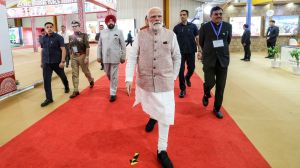Glass is half full
United Spirits Limited,the flagship company of the UB group,has made history by posting sales of 100 million cases...
United Spirits Limited (USL),the flagship company of the UB group,has made history by posting sales of 100 million cases in the fiscal year ending March 2010,displacing the Paris-based Pernod Ricard as the worlds second largest spirit company in volume terms. And the company now has ambitions to move up to the top global position in the next fiscal year. USL,which traces its history back to the erstwhile McDowell & Co,which was established as a proprietary business in 1826,has certainly come a long way with 80 bottling units and a portfolio of more than 140 brands sold through 64,000 retail outlets.
It also has some outstanding innovative products like the first single malt manufactured in Asia and the first diet whisky in the world. The USL success is all the more remarkable given that Indias success in manufacturing has been so far limited to a few niche areas like engineering products and chemicals. So,this novel achievement in the global spirits market is commendable as it heralds Indias entry into the important segment of lifestyle products.
A major breakthrough that helped USL notch such significant gains was the acquisition of the Glasgow-based Whyte and Mackay in 2007,which ramped up its premium scotch and single malts portfolio and gave it ownership of four malt whisky distilleries in Scotland and a bottling capacity of 12 million cases per annum. Earlier,the company had also made an entry in the wine category through the acquisition of Bouvet Ladubay,a French company,in 2006,with a capacity of 8 million bottles per year,which is sold in over 38 countries.
An important aspect that differentiates USLs achievements from other recent gains in global markets is that the achievement was almost entirely from domestic markets. For instance,USLs annual report for 2008-09 shows that of the total sales of Rs 7,113 crore in 2008-09,the companys total exports and foreign income earnings were only Rs 4.2 crore.
This is in striking contrast to the performance of Pernod Ricard,the French company that USL replaced in the second position. Figures for 2008-09 show that of its total sales of 7,203 million euro in 2008-09,the French markets accounted for sales of just 735 million euro. Sales were more than 2,000 million euro each in other markets in Europe,the Americas and Asia. The highest share of its profits came from the Americas (636 million euro),followed by Europe (537 million euro) and Asia (495 million euro). Frances contribution to the total profits was only a marginal 178 million euro.
USLs complete dependence on local markets for generating volumes can be attributed to many reasons. One was that the double-digit growth in the domestic market in recent years has eroded all incentives to extend market reach beyond the borders. The numbers on Indias stunted export market for spirits speaks volumes of the insular outlook of the industry. Though India is the third largest market for alcoholic beverages,with a total sale of 200 million-plus cases,the spirits exports in 2008-09 was minuscule. The largest spirit exports was that of whisky (Rs 251 crore) followed by liqueurs (Rs 20 crore),rum (Rs 12 crore),gin (Rs 3 crore) and vodka (Rs 2 crore). This is in sharp contrast to the spurt in export performance in other manufacturing areas. Indias competitive strength has improved in recent times in areas like chemical and engineering products,where the exports have touched $22.6 billion and $47.2 billion,respectively.
The poor export performance of the spirits companies can also be attributed to the high tariff walls put up to protect domestic industry. Indian has bound the basic customs duty at 150% of the product value to which it adds other state and central taxes,which makes imports prohibitively expensive.
An excessively protected domestic market has had a negative impact on the competition in the industry,which was dominated by a few firms. In fact,USL alone accounts for 59% of the Indian spirits industry in volume terms. Estimates made by government agencies in the middle of the decade indicate that the four large producers alone controlled three-fourths of the market for branded spirits while two players alone account for a similar share of the beer market.
Consequently,the highly protected domestic market has been dominated by cheap products. A large part of the spirits consumed are country liquor. And most of the Indian-made foreign liquors consumed are poor replicas of the original products,made almost entirely from molasses which are then flavoured and sold as whisky,brandy,rum,gin and vodka.
Another factor that hinders the growth of competition and improvement in the quality of Indian spirits is the excessive influence of the government. Apart from licensing production and limiting imports,the government also imposes excessively high taxes,which account for as much as 60% of the final product prices. And to cap it all,almost two-thirds of the spirits sales are made to government buying agencies that dictate terms,seek rent and arbitrarily distort market signals that are essential for the growth of a dynamic industry. In such a scenario,the domination of Indians companies in the global rankings would contribute very little to expanding its share in the global markets.





- 01
- 02
- 03
- 04
- 05


























